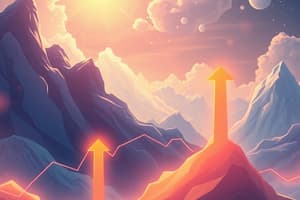Podcast
Questions and Answers
What does Gross Domestic Product (GDP) measure?
What does Gross Domestic Product (GDP) measure?
- The market value of all final goods and services produced within a country (correct)
- The annual income of households within a nation
- The total wealth held by a country's residents
- The total investments made by foreign countries in a nation's economy
Which of the following is NOT included in the GDP calculation?
Which of the following is NOT included in the GDP calculation?
- Exports
- Stock market transactions (correct)
- Government Purchases
- Consumption
What is an example of structural unemployment?
What is an example of structural unemployment?
- Workers laid off due to factory automation (correct)
- A person taking time off between jobs for personal reasons
- A recent college graduate searching for her first job
- Individuals unemployed during a recession
What does the Consumer Price Index (CPI) not consider?
What does the Consumer Price Index (CPI) not consider?
How is the unemployment rate defined?
How is the unemployment rate defined?
What characterizes an inflationary gap?
What characterizes an inflationary gap?
In which scenario would actual inflation be less than expected?
In which scenario would actual inflation be less than expected?
Which of the following statements about the Circular-Flow Diagram is correct?
Which of the following statements about the Circular-Flow Diagram is correct?
Which of the following best describes cyclical unemployment?
Which of the following best describes cyclical unemployment?
What does the Labor Force Participation Rate measure?
What does the Labor Force Participation Rate measure?
Flashcards
What is GDP?
What is GDP?
The market value of all final goods and services produced within a country in a given period of time.
What are the four components of GDP?
What are the four components of GDP?
Consumption, Investment, Government Purchases, and Net Exports (Exports - Imports).
What does the Consumer Price Index (CPI) measure?
What does the Consumer Price Index (CPI) measure?
Measures the overall price level and the cost of a basket of goods and services bought by a typical consumer.
What is annual inflation?
What is annual inflation?
Signup and view all the flashcards
Who is considered unemployed?
Who is considered unemployed?
Signup and view all the flashcards
What is the labor force?
What is the labor force?
Signup and view all the flashcards
What is the labor force participation rate?
What is the labor force participation rate?
Signup and view all the flashcards
What is structural unemployment?
What is structural unemployment?
Signup and view all the flashcards
What is frictional unemployment?
What is frictional unemployment?
Signup and view all the flashcards
What is cyclical unemployment?
What is cyclical unemployment?
Signup and view all the flashcards
Study Notes
Gross Domestic Product (GDP)
- GDP measures the market value of all final goods and services produced within a country in a given period.
- GDP does not include tax and stock.
Factors of GDP
- Consumption
- Investment
- Government Purchases
- Net Exports (Exports - Imports)
Consumer Price Index (CPI)
- CPI measures the overall level of prices
- Formula: CPI = (Current basket / Base year basket) x 100
- Percentage change in CPI represents inflation.
CPI Weaknesses
- Substitution bias (some prices rise faster than others)
- Consumers buying more cheaper products
Cost of Living
- CPI often overstates the rise in the cost of living due to substitution bias
Unemployment
- Unemployed: Not working, actively looking for work
- Labor Force: Employed + Unemployed
- Unemployment Rate: (Number of Unemployed / Labor Force) x 100
- Labor Force Participation Rate: (Labor Force / Population) x 100
Types of Unemployment
- Structural: Skills no longer needed by the market; requires retraining
- Frictional: Workers between jobs; temporary
- Cyclical: Related to economic downturns
Circular Flow Diagram
- Shows the flow of money and goods/services between firms and households
- Includes consumption, production, factor markets and leakages.
Inflationary vs Contractionary Gaps
- Inflationary Gap: Real GDP > Potential GDP
- Contractionary Gap: Real GDP < Potential GDP
Stagflation
- Combination of high inflation and slow economic growth
- Often caused by supply shocks (negative shocks to the supply of goods) or poor economic policy.
Studying That Suits You
Use AI to generate personalized quizzes and flashcards to suit your learning preferences.




